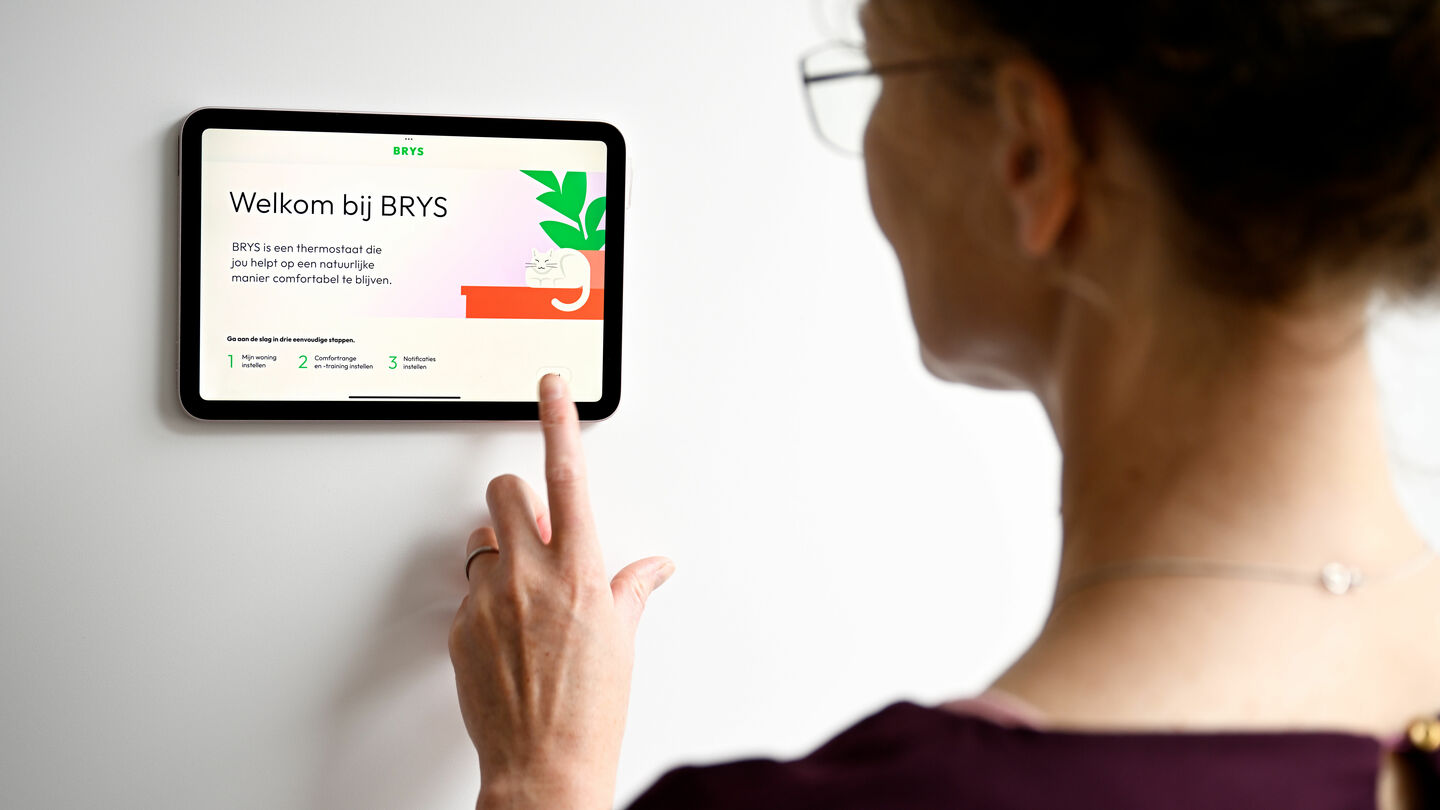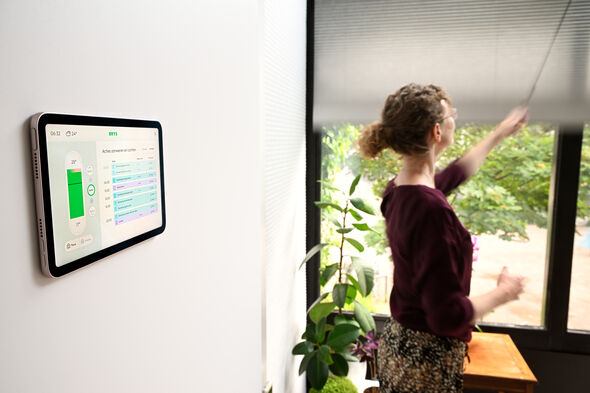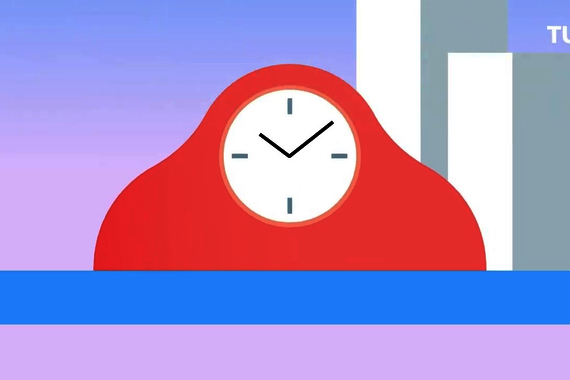
Prof talk | Staying naturally cool without air conditioning
TU/e researcher develops smart thermostat that encourages natural cooling
Many Dutch households switch on the air conditioning as soon as temperatures rise. But that comfort comes at a cost: air conditioners consume a lot of energy and contribute to climate change. TU/e researcher Lenneke Kuijer developed BRYS, a smart concept thermostat that focuses on natural ventilation, shading, and a broader comfort range. This way, you can stay comfortable during a heatwave – even without air conditioning.
“In the Netherlands, we don’t have a strong historical relationship with heat, so we never really learned how to deal with it,” says Lenneke Kuijer, assistant professor at the TU/e Department of Industrial Design. “In warmer countries, people grow up learning how to deal with heat from an early age, often through habits passed down by their parents. But here in the Netherlands, that experience is missing, and now that temperatures are rising, we have to learn quickly.”
Energy-consuming devices
She observed a sharp rise in the use of air conditioning in Dutch homes. This is due not only to rising temperatures, but also to the expectation that things will only get hotter. “Climate change is a major theme in the media. So when there’s a heatwave, people don’t see it as an exception, but as confirmation: ‘See, this is going to happen more often,’” she explains. “That creates the idea that you need to arm yourself against the heat.”
The high energy consumption of air conditioners leads to significant CO₂ emissions, which in turn contribute to global warming
“There’s also a big inequality aspect to this – not everyone can afford such a device,” Kuijer notes. Moreover, air conditioners consume large amounts of energy, further impacting the climate. “That high energy consumption leads to significant CO₂ emissions, which in turn contribute to global warming. It’s actually quite ironic: we use air conditioners to fight the heat, but in doing so we’re worsening the problem.”
She also found that people often set their AC to 20–21 degrees Celsius, even though they don’t report feeling too hot until around 25 degrees. In other words: we set the air conditioning too low, wasting a lot of energy. So Kuijer’s central research question became: how can we improve our comfort on hot days without immediately resorting to power-hungry appliances?
Ventilation, shading, and comfort range
The solution, according to Kuijer, lies in three strategies: smarter use of ventilation, targeted use of sun shading, and expanding our comfort range. “With ventilation and shading, you try to actively keep indoor temperatures down,” she explains. “But that broader comfort range is about learning to cope with heat without necessarily trying to change your environment.”
This last point is especially important, Kuijer says, because it not only saves energy but also gives you greater freedom. “By tapping into your own adaptability, you can feel more comfortable anywhere – even without your environment being adjusted for you,” she emphasizes. “After all, you won’t always be able to control your surroundings.”
Unexpected obstacles
Kuijer collaborated with experts from various disciplines to approach the issue from multiple perspectives. Only with such a broad view and attention to real-world behavior can you develop solutions that truly work, she argues. This revealed some surprising obstacles. “In the Netherlands, many people are afraid to leave their windows open at night because of burglary risks. Unlike in some other countries, bars on ground-floor windows aren’t common here. Nor are proper insect screens, even though those factors influence the decision to open a window.”
During the day, people often open windows and doors – exactly when they shouldn’t. “If it’s warmer outside than inside, you should really keep everything closed,” Kuijer explains. “But people have a strong tendency to let in ‘fresh air,’ hoping for a cool breeze. In reality, that just causes the indoor temperature to rise.”
Learning new habits
In theory, none of this is complicated. “If you search online, you’ll quickly find dozens of websites giving the same simple advice: keep your windows and curtains closed during the day, and open everything up at night,” says Kuijer. “But in practice, it’s hard to follow this advice consistently. These behaviors aren’t yet ingrained in our daily routines.”
That’s exactly why she developed BRYS: a smart concept thermostat that supports people in learning new behavior. “I want to encourage companies in the HVAC sector (Heating, Ventilation and Air Conditioning, ed.) to incorporate these kinds of concepts into their offerings. Because I believe the Dutch really need a little support in developing new habits.”
BRYS measures indoor and outdoor temperatures and provides advice, for instance, on the best time to ventilate or keep windows closed. Importantly, the system is deliberately designed not to take over all decisions. “It’s more like a collaboration,” Kuijer explains. “The system helps you gain insight into what’s smart to do, so you learn from the experience.”
Comfort training
BRYS also includes a comfort training module, helping users gradually expand their comfort range. By helping people slowly get used to higher temperatures in the summer – and lower ones in the winter – they can feel better within a broader temperature spectrum. That means less dependence on air conditioning or heating, which saves money and is better for the environment.
If you don’t feel comfortable at a particular moment – say, because you’re feeling unwell – you can activate the boost function. This temporarily turns on cooling or heating so you can quickly get relief, without the system reverting to standard settings that use a lot of energy.
Surprisingly simple
So do we really need air conditioning in the Netherlands? “High temperatures often mean you need to slow down a little – but not everyone is in a position to do so. There are also vulnerable groups for whom cooling is absolutely essential,” Kuijer says. “But let’s reserve air conditioning for those vulnerable groups, or for situations where there’s truly no other option.” In most homes with healthy adult residents, she believes it’s perfectly possible to keep the indoor climate comfortable in natural ways – without AC.
At a time when we reach for new technology or gadgets to solve every problem, BRYS is a refreshing return to basics. Rather than offering yet another smart innovation, it focuses on simple actions that have proven their value for generations. The system shows that effective solutions can be surprisingly simple – and that caring for the planet doesn’t mean you have to sacrifice comfort. “I believe there are many opportunities to improve our well-being while also reducing our footprint,” Kuijer says. “That makes me hopeful. As a researcher focused on sustainability, I try to seek out exactly these kinds of win-win situations.”




Discussion